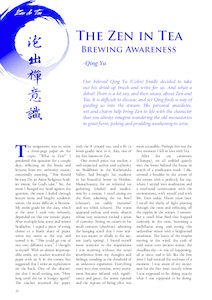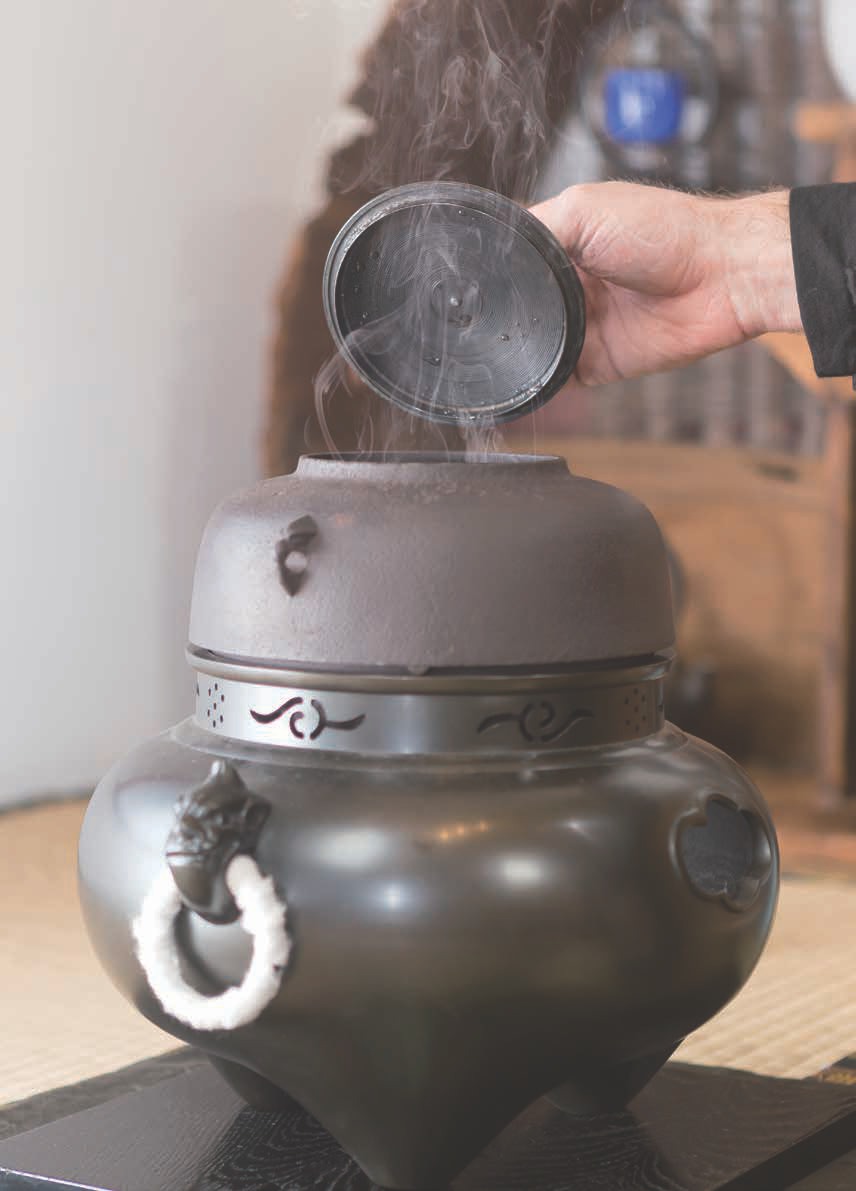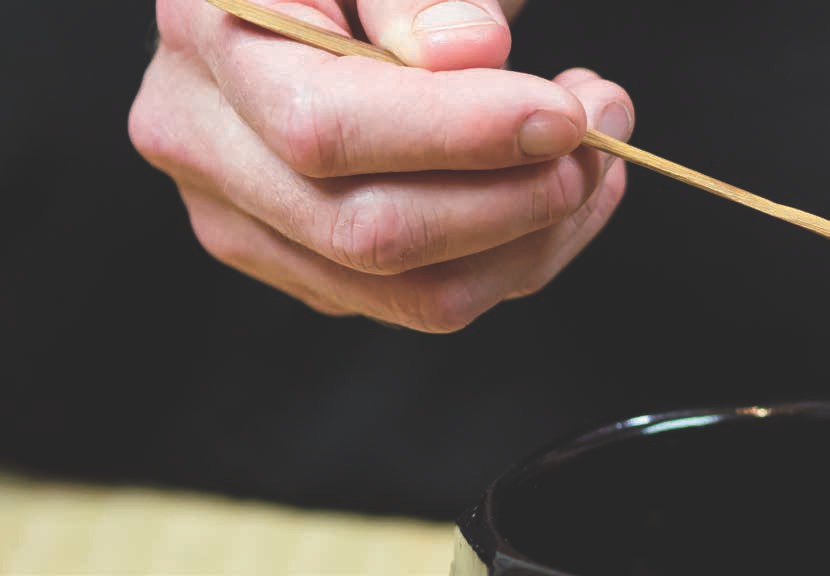
 |
|
泡 出 禪 意 識
The assignment was to write a three-page paper on the topic, "What is Zen?" I pondered this question for a couple days, reflecting on the books and lectures from my university course, conceitedly asserting, "This should be easy, I'm an Asian Religious Studies minor, for God's sake." Yet, the more I banged my head against the question, the more I leafed through lecture notes and lengthy academic tomes, the more difficult it became. My entire grade for the class, which at the time I took very seriously, depended on this one measly paper. After multiple false starts and minor headaches, I taped a piece of string cheese to a blank sheet of paper, wrote my name at the top, and turned it in. "This could go one of two very different ways," I thought to myself. With an almost imperceptible smile, my teacher returned the paper with an A in the corner, but suggested that I write an explanation on the back. One of the obscurities that I recall writing was, "How long until the rat is hungry again?" The teacher returned the paper, with the A crossed out, and a B+ (a lower grade) next to it. Alas, one of my first lessons in Zen.
One month prior, our teacher, a well-respected author and authority on Buddhism in the Kathmandu Valley, had brought his students to his beautiful home in Holden, Massachusetts, for an informal tea gathering (chakai) and meditation by a stream. I recall sitting on the floor, admiring the tea bowl (chawan), tea caddy (natsume) and tea whisk (chasen). The wares appeared archaic and worn, objects whose very existence evoked a sense of curiosity. Sitting on tatami in his small tearoom (chashitsu), admiring the hanging scroll that I now realize was meant to allude to the season (early spring), I found myself more attentive to the impressions I was receiving without the usual interference from my thoughts and feelings, standing at the threshold of an unknown experience. Everything went into slow motion, every movement became infused with significance and grace, the senses opened and the rapture of being alive was more accessible. Perhaps this was the first moment I fell in love with Tea.
After the tea ceremony (Chanoyu), we all ambled quietly into the forest behind the house in search of a meditation nook. I discovered a boulder in the center of the stream with a perfectly flat top, where I settled into meditation and a newfound communion with the environment, with myself and with life. Even today, fifteen years later, I recall the shafts of light piercing through the trees and reflecting off the ripples in the stream. I remember a small blue bird that hopped curiously in the trees, humming a mellifluous song, and eyeing this unfamiliar visitor with a heightened awareness. The leaves of the maples moving in the wind, the rush of cold water over ancient stones, the cloudless sky - it was all happening, all at once, and it felt like the first time I had noticed the suchness of a moment. I was aware of my awareness for the first time: exactly where I was supposed to be, doing exactly what I was supposed to be doing. I was manifesting my purpose in that moment. And I realize now that this manifestation is at the heart of Zen.

If asked The essence of Chado, Say it's the sound Of windblown pines In a painting.
Zen master Shunryu Suzuki, a direct spiritual descendent of the great 13th century master Dogen, puts it like this, "You may think that if there is no purpose or no goal in our practice, we will not know what to do. But there is a way. The way to practice without having any goal is to limit your activity, or to be concentrated on what you are doing in this moment. Instead of having some particular object in mind, you should limit your activity. When your mind is wondering about elsewhere you have no chance to express yourself. But if you limit your activity to what you can do just now, in this moment, then you can express fully your true nature, which is the universal Buddha nature. This is our way." (Zen Mind, Beginners Mind)

This was my first introduction to Zen and Tea, and this experience was the inspiration for the string17/ The Zen in Tea cheese paper one month later. The minute I offer you an explanation, my grade starts plummeting, so I will only point my finger at the meaning. Zen is beyond words, beyond concepts, beyond the rational mind. It accounts for the totality, while not losing itself in the void. One definition of Zen is: doing one thing at a time. In the Way of Tea, this means brewing tea with your whole being, with all of your awareness, with your mind and body unified in the art of the ceremony.
Most tea lovers have at some point in their journey with the Leaf encountered this beautiful passage by the Indian mystic and teacher Osho: "To make tea a meditative ceremony is just symbolic. It shows that any mundane activity can become meditation. Digging a hole in the garden, planting new roses in the garden... you can do it with such tremendous love and compassion, you can do it with the hands of the Buddha. There is no contradiction. The tea ceremony is only the beginning. I say unto you: Your every act should be a ceremony. If you can bring your consciousness, your awareness, your intelligence to the act, if you can be spontaneous, then there is no need for any other religion, life itself will be the religion." (The Everest of Zen, with Basho's Haikus) Thus, tea is a Zen practice because it is a time in our day when we set everything else aside - to be fully with this act, this moment, this way... The practice of anything implies that you do it repeatedly, and this act of repetition reinforces and cultivates a special quality. Some of the qualities we are working for in Zen are continuous awareness, consciousness, carefulness and respectfulness. If treated this way, the practice begins to bleed into our prosaic lives, our work, our relationships, our entire existence. To live with and to embody these qualities is to live with Zen.
Osho uses the phrase, "Do it with the hands of the Buddha," and this is a wonderful place to start. When brewing tea, we might task ourselves with bringing tremendous awareness to our hands. It is, after all, our hands that carry out the tasks of our intention and attention in brewing tea. Can we sense our hands, the energy and fine movements required to brew a cup of tea? We can start here, by feeling our hands with great attention and paying homage to the Leaf, by mindfully handling the leaves, the scoop, the kettle, the pot, the cups, the setting of the chaxi, the serving of the tea and the cleaning of the wares afterwards. One might say, "Well, this approach sounds like self-awareness or self-consciousness, and I thought Zen was all about overcoming this obsessive self-consciousness, this 'self ' altogether..." Here, we must remember that Zen maintains through all of its art forms, including tea, a deep reverence for spontaneity and naturalness. We must remember these qualities as a backdrop when considering the disciplined regimen of Japanese Zen monasteries. In the words of the great Tang Dynasty master Linchi: "In Buddhism there is no place for using effort. Just be ordinary and nothing special. Eat your food, move your bowels, pass water and when you're tired go and lie down. The ignorant will laugh at me, but the wise will understand."

Oftentimes, the ideal state of being in Zen is described as a perfectly tuned instrument. If the instrument is too tight, like a person too intensely self-conscious, the strings will break. Whereas, if the strings are too loose, the instrument will not yield its intended harmony. Thus, we seek to maintain enough tension, enough tightness, to remain alert, mindful, present and aware, while also remaining loose enough in our body and mind to take in and respond to the entirety of our experience. If we are too tight, how then will we consider and feel the heart of our guests, as advised by the 16th century tea master Rikyu? Too loose, and we become lost in life, adrift in daydreams, imagination, images, words and emotions - lost in an existence that is not the reality of this moment. Too tight, and we become unable to relax, which is a prerequisite for naturalness, spontaneity and the open reception to other forces in this great Life. Thus, in this subtle balance, this space between, there is a crack through which the light of Zen shines through our tea. There is a difference between the state we experience in quietude and our state in the activities of life. The practice of Chado, of Zen and Tea, is the cultivation of a continuum between these two states. Through continuous practice, our tea becomes infused with Zen. Eventually, this extraordinary quality becomes our way of life - the possibility of awakening and the greatest gift we can offer another human being: Presence.
